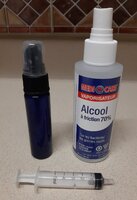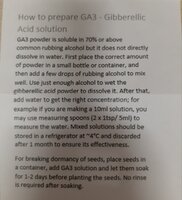CADBOY
Well-Known Member
Hey all,
This is a quick "How to" thread on how exactly to mix up some Gibberellic acid (GA3)...
I'm doing this to help anyone who doesn't already know how exactly to do this. Enjoy!
You need some things to start;
#1) Gibberellic acid (GA3)
#2) 70% Rubbing Alcohol
#3) Water 10 Millilitres
#4) 5 ml syringe or other measuring device
#5) Little spray bottle to hold everything
Follow the photos for directions below!
For more general information and great detials on how to use GA3 or another detailed way to mix up some GA3 check out Celts 2020 Grow link.
This is a quick "How to" thread on how exactly to mix up some Gibberellic acid (GA3)...
I'm doing this to help anyone who doesn't already know how exactly to do this. Enjoy!
You need some things to start;
#1) Gibberellic acid (GA3)
#2) 70% Rubbing Alcohol
#3) Water 10 Millilitres
#4) 5 ml syringe or other measuring device
#5) Little spray bottle to hold everything
Follow the photos for directions below!
For more general information and great detials on how to use GA3 or another detailed way to mix up some GA3 check out Celts 2020 Grow link.






